Racial Politics in Latin America: What Race in Another America Tells Us About Our Destiny, Part 1
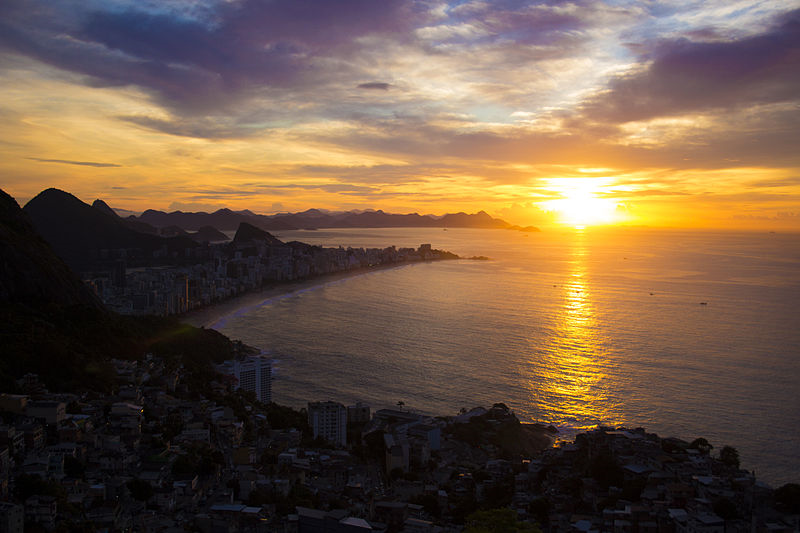
Rio as seen by helicoptering elites.
Darkness fell over the São Paulo skyline. Like most cities, dusk brings the evening commute, but this one is a little different. One by one, all across the business district, helicopters lifted off buildings and roared into the humid night sky.
São Paulo has one of the largest private helicopter fleets in the world. Usually they are ferrying wealthy businessmen home, but sometimes a trip can include discreet female companionship and a hop to a nearby club. It has been this way for years. When the city still allowed electronic billboards, people said it reminded them of the movie Blade Runner.
“My favorite time to fly is at night, because the sensation is equaled only in movies or in dreams,” said one local businessman. “The lights are everywhere, as if I were flying within a Christmas tree.”
The view is nice, but the real reason is more prosaic. Like the future dystopia of Blade Runner, life is more dangerous on the ground. Criminals make a good living kidnapping business executives or members of their family. Fear has driven a similar business in bullet-proof cars.
The city is no less dangerous for the poor in the favelas, but their lives are worth a lot less. Some say that nearby Rio de Janeiro is using secret sniper teams to take out suspected criminals from afar. Anyone seen carrying a gun is a potential target — shoot to kill.
Such overwhelming disparities of wealth and poverty help define Rio and São Paulo, but it is not much different in the other mega cities like Lima, Buenos Aires, or Mexico City. This is the stark reality of Latin America, but it is also more than that. It is a window on America’s future.
Race in Latin America
The United States is currently on track to become a majority-minority nation by the year 2045. Considerable uncertainty surrounds this coming milestone, but we are not flying completely blind. In nations all across Latin America, Whites are already a minority or fast approaching that point. Given that many of our newest immigrants are from this part of the world, the region deserves a closer look. What is life like there? How are Whites treated? What lessons can we learn?
Latin America’s racial dynamics are a product of its history. Its current racial makeup is the result of five historic waves of immigration — a first wave that came over the land bridge from Asia and produced the original native peoples; the later conquests by the Spanish and Portuguese after 1492; a subsequent importation of Black slaves to the Caribbean and South American coast; a fourth wave of European immigration beginning in the mid-1800s; and a fifth wave of internal migration from rural areas to the cities, which created its modern urban slums.
The fourth wave from Europe was responsible for what is today the Whitest portion of the continent, an area centered on Uruguay on the southeastern South American coast. From there, the White population extends northward into southern Brazil and southwest into neighboring Argentina, particularly Buenos Aires where the city’s White porteños (“people of the port”) are internationally known for their alleged arrogance toward Browner Latin Americans. Despite the concentration of Whites in the area, however, their percentage peaked in the middle of the twentieth century. It has been declining ever since, partly due to lower birthrates and partly because of the internal migrations of the last wave.
Most of the rest of Latin America is primarily Black, Indigenous, or mixed-race. The last of these is mostly due to what probably seemed like a minor issue when the continent was first colonized by the Spanish and Portuguese. Unlike the British, the conquistadors brought relatively few White women with them. Even during the period of regularized Spanish and Portuguese immigration that followed, White women never came close to equaling the number of White men immigrating to the New World. The predictably high levels of miscegenation that resulted, particularly when coupled with a major disease-driven die-off among the Indigenous peoples, created the large mestizo and mulatto populations that today predominate across most of the continent.
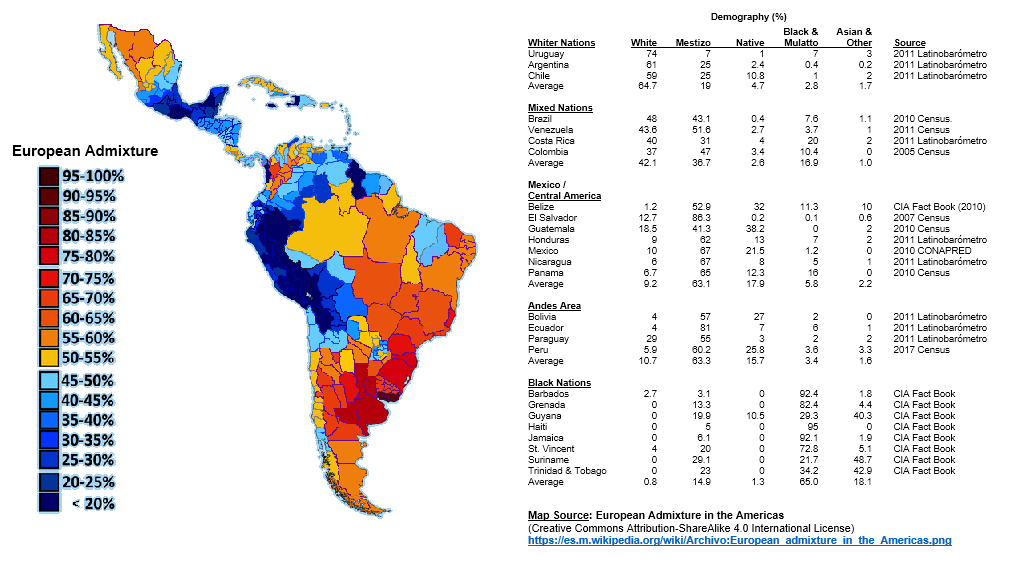
This cornucopia of diversity has provided little benefit. As in the United States, race in Latin America correlates strongly with IQ, education, and income. Other analyses have found similar correlations even within the mestizo and mulatto populations, with the lighter-skinned generally achieving higher educational and occupational status than those with darker skin.
At the national level, Whiter nations like Uruguay, Argentina, and Chile have substantially higher average incomes and lower levels of poverty than other nations that are Browner and Blacker. This pattern can also be found within nations, with Indigenous areas and the Black and Brown slums surrounding major cities all overwhelmingly poor.
Crime also correlates with race, with the highest homicides rates usually found in Brown and Black urban areas. Latin America is overwhelmingly overrepresented among the rankings of the world’s most crime-ridden cities. This has produced correspondingly high levels of racial segregation all over the continent.
These recurring economic and social disparities are nothing new to those who live in the region. They merely document an underlying phenomenon that has been well-known for centuries. Latin America society is overwhelmingly stratified by race. Variations of the same pattern repeat themselves just about everywhere — a wealthy White elite at the top, the rest of the White population just below them, mixed-race mestizos and mulattos further down, and Black and Indigenous peoples at the bottom (see below). Asians are a small minority and thus not included, but they generally do about as well as Whites, or nearly so.
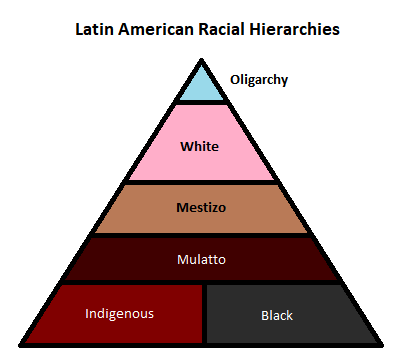
This preference for Whiteness has a long history. It dates back to the Spanish racial caste system that emerged in colonial times and continued into the nineteenth and twentieth centuries, when Whitening (blanqueamiento) policies were put in place to promote immigration from Europe to “improve the race” (mejorar la raza). It still prevails in the Latin American media, where Whites are overrepresented and European beauty standards predominate. It also drives the dating market, where everyone is looking for someone Whiter to date or marry.
“Many of us have relatives who subscribe to Eurocentric standards of beauty,” wrote one Latina, expressing a common sentiment. “We hear abuelas (grandmothers), tias (aunts), or even mothers encouraging their children not to marry a darker skinned, Indigenous, or Black Latino in fear that they will bring ‘ugly kids’ into the world with dark skin, wide ethnic facial features, and curly, kinky hair that’s still often referred to as ‘pelo malo’ (bad hair).”
Political History
Latin America’s inequality and overwhelming levels of Brown and Black poverty provide insights on America’s future. But beyond an increase in de facto segregation, which already exists, and the threat of increased crime, this does not by itself constitute a major threat to America’s White population. The real threat is political, where such demographic change could empower a rising Democratic Party that is increasingly hostile to White interests. What can Latin American politics tell us about our political future?
Democracy in Latin America, at least in limited form, dates back to the early 1800s, shortly after independence was achieved from Spain and Portugal and not long after democracy arose in the United States. Since then, most Latin American nations have cycled back and forth between democracy and dictatorship, with left-leaning elected governments that displeased the ruling oligarchies frequently removed through military coups. In all, an estimated 250 coups have taken place over the past two centuries.
The United States began to play a dominant role in the region after the Spanish-American war of 1898, a period when it was just coming into its own as a world power. In the years that followed, it increasingly exercised that power on behalf of US corporations like United Fruit in nations like Honduras and Guatemala, two stereotypical banana republics. John Foster Dulles and Allen Dulles both worked for United Fruit and later took this outlook to the State Department and CIA under Eisenhower. There they pressed for tougher measures to contain communism and support American business interests. The 1954 coup in Guatemala was an opening salvo in this wider war.
After the Bay of Pigs fiasco, President Kennedy attempted a more liberal outreach policy, but this strategy was soon set aside by LBJ, Richard Nixon, and Gerald Ford, all of whom took a harder line. In the years that followed, one democracy fell after another with active CIA involvement or tacit American support. These included Bolivia (1964), Brazil (1964), Argentina (1966), Peru (1968), Bolivia again (1971), Ecuador (1972), Uruguay (1973), Chile (1973), and Argentina again (1976). By the mid-1970s, most Latin American nations were military dictatorships.
With American support, the dictatorships went to extreme lengths to hold onto power. In 1975, the governments of Chile, Argentina, Bolivia, Paraguay and Uruguay jointly launched Operation Condor, which killed as many as 30,000 leftist political opponents and imprisoned another 400,000. These efforts continued in Argentina for nearly a decade as part of the so-called Dirty War, where some victims were “disappeared” by choppering them out to sea and dropping them in the ocean to drown. The Guatemalan Civil War against various leftist groups (1960–1996) resulted in another 200,000 deaths, including wholesale massacres in hundreds of villages. Another 75,000 died in the civil war in El Salvador, where death squads and child soldiers were commonplace, and another 30,000 died in Nicaragua.
Throughout this period, however, change was brewing in the American foreign policy establishment. As far back as the failure of Woodrow Wilson’s League of Nations, there had been a decades-long debate between liberals, who championed internationalism and democracy, and pragmatists who championed realpolitik and the national interest. Realpolitik won out during most of the Cold War, at least on military matters, but the liberals pressed ahead on the economic front. After World War II, they built a post-war framework based on free trade, international law, and a related set of policies and institutions such as the Bretton Woods agreement, GATT, OECD, and the United Nations.
Over time, and with the crucial backing of multinational corporations and other wealthy business interests, a new neoliberal framework emerged that focused on economic development, globalism, and democracy, and this became the new establishment consensus. Pitting liberal ideals against pragmatism was a false choice, they argued, because internationalism and economic prosperity create peace while nationalist sentiments were the cause of war. (In reality, war long predates the existence of nations.) Democracy was an important element in this new worldview because, they claimed; democracies rarely go to war with one another.
By the time the Cold War ended, this view had won out. George H.W. Bush, the quintessential establishmentarian who was once a CIA war hawk, reflected this change in elite thinking almost perfectly. During his inaugural address, he argued that a “new breeze was blowing” toward democracy. He later proclaimed his support for a “New World Order” of internationalism. Francis Fukuyama called it the “The End of History.”
Latin America’s journey to democracy was a product of this larger shift in establishment thinking, but it came a bit early. Jimmy Carter began the process with a push for human rights in the late 1970s, but his efforts were sidelined by Reagan’s election in 1980. Reagan initially sided with the pragmatists, but by 1983 he had changed sides, now viewing democratization as useful tool in his ongoing public relations war with the dying Soviet Union. This shift signaled the ascendance of the establishment consensus even within conservative GOP circles.
Reagan’s support for democratization had a decisive impact. Not long afterward, the Latin American dictatorships began to fall. The inherent fragility of the regimes might seem surprising, given the extremes to which they had been prepared to stay in power, but most dictatorships fall eventually. Usually it is due to some combination of poor leadership, bad management, a bad economy, or some other major mistake that costs them the support of even their local elites. The entire region was struggling with a major debt crisis at the time. Once the US withdrew its active support for military rule, there was little left to prop them up. By the time the Cold War ended in 1989, most of the region had returned to democracy.
At least at first, it seemed like the establishment’s gamble had paid off. Most of the new democracies elected moderate or conservative governments that proceeded to implement the standard Washington Consensus package of privatization, deregulation, and tax and spending cuts.
When these policies failed to produce visible benefits for most of the poor and middle class, however, the leftist surge finally began. Starting with the election of Hugo Chavez in Venezuela in 1998, a wave of leftist regimes called the Pink Tide vaulted to power (see below).
This Pink Tide, however, was short-lived. Like the conservative neoliberal governments before them, the left was unable to make more than modest improvements in the lives of the poor (in fact, many Pink Tide governments were cornered into implementing the same neoliberal policies as their predecessors). Moreover, much of what they accomplished had rested on a temporary boom in commodity prices, which was an economic house of cards. Faced with faltering economies, soaring crime, and rampant corruption, a majority of the voters shifted right again and the left was swept from power.
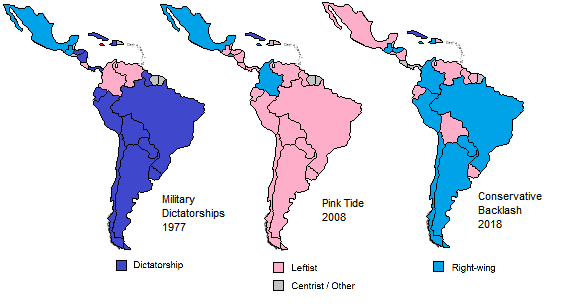

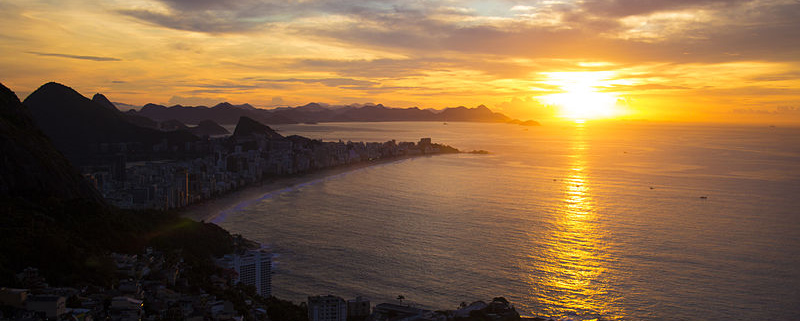




“Eurocentric standards of beauty”
Notice that the author or the Latina then goes on to elaborate on that which is aesthetically pleasing to ‘human’ eye not just the ‘European’ eye.
‘Eurocentric’ is redundant.
The problem with superficial stuff, which the Occidental Observer specialises in, is that it has no long-term predictive value, because Jewish material is omitted. Many whites emigrated to South America, but Jewish plans are not factored in. Maybe after South Africa, European countries, US States, Canada, ANZ there are Jewish plans for south America. It would be naive to think otherwise.
Light on the JQ? Are you serious?
Venezuela with the largest oil reserves in the world is a Shitole, the white minority escaped Chavismo. Southern Brazil in the states of Santa Catarina and Rio Grande do Sul border Argentina and Uruguay were colonized by Europeans mainly Germans and Italians. They are the safest and most civilized.
Chile, where there were no blacks, during the government of Michele Bachelet, president from 2014 – 2017, hundreds of thousands of Haitians arrived in illegal secret flights, and distributed throughout the country, it looks like an African country. Bachelet UN the prize with the position of commissioner of human rights for having Africanized Chile. Interestingly, Bolivia is growing a lot, mainly Santa Cruz de la Sierra, the whitest area of the country, and white immigrants and some Asians continue to arrive, there are no blacks.
Blumenau, Santa Catarina Brazil.
https://www.youtube.com/watch?v=pCSPikNe5UY&t=5s
Note the growing phenomenon of property acquisition by foreign oligarchs in Patagonia. Argentina’s Jewish population is the fourth largest outside of the US and Israel.
https://www.mintpressnews.com/dark-secret-behind-british-billionaire-joe-lewis-parallel-state-in-argentina-patagonia/256068/
What an article! What a story! Reading this makes me feel I have been utterly blind to a major conspiracy unfolding in this hemisphere.
A brief reference in the article to Argentinians’ ongoing resentment over the Falklands War and the peace treaty “imposed” on them after the decisive British victory has got me wondering whether there was a proximate Jewish interest in escalating the conflict from nasty words to deadly force. Up to the present moment it’s always seemed to me that Argie machismo was the root problem—and hence that when the shooting began, they got no more than what they had coming—but once one has awakened to the utility of incorporating “cherchez le Juif” as a routine part of geopolitical analysis, nothing ever again looks quite the same.
Anyone who reads this blood soaked historical account of what the criminal and corrupt, USA leadership has done by meddling in the affairs of these Latin and South American nations – and if you are a racially awake White American, try to imagine becoming a hated and despised minority and subjugated to being ruled over by a Hispanic and black majority United States. These brown and black and mongrelized hordes do not make a distinction between the White elites who were directly responsible for all the death, misery and chaos – and the average White man or White woman on the street who had no role in any of this carnage. But, once these brown and black and mixed race hordes become the majority – they Will be screaming that it is payback time.
And, the White elites and the jewish elites will be safely behind their gated and guarded walls, inside their mansions and compounds – while the regular middle class White family will be recipients of the violence that I am certain these browns and blacks are planning.
” Faced with faltering economies, soaring crime, and rampant corruption, ”
None of these characteristics of these places are the fault of the USA or foreign interference, they are a consequence of the type of people who live there.
Places like ZImbabwe are the same. The only time the blacks in Zimbabwe had plenty of food, jobs & tribal peace was when a small minority of white people were in charge during colonial times, and these whites were from an era when the white elites in these places were not corrupt socialists themselves.
A return to this rule by whites for 3rd world countries will not be possible for any of these types of countries, as first of all, whites now think it is immoral to rule colonies, but secondly, even if whites did decide to run a colony, the white elites are now socialists, and socialists are themselves corrupt and incompetent and so could no longer manage the task of running a colony.
I do not think that their compounds will be so safe with today’s technology. There were thousands of very angry people that stormed Versailles when the proles had had enough with the inequity.
When I resided in Europe several students from Uruguay were befriended. Their phenotypes were similar to most Central Europeans (Balts, Czechs, Germans, Magyars and Poles). Due to past experiences, it seemed they were kept at a distance from flat nose elements who also were brought in by Red govs. Until recently we kept in contact with one another (4 of them and me). All were elite regarding intellectual ability and economics. Their take on So. Am was that, other than Argentina and Uruguay, there would eventually be ethno war; the region of Central Chile might evolve into or obtain some sort of autonomy. Can’t wait for part 2 of this communique.